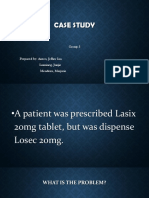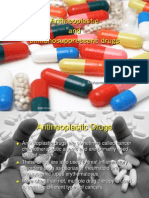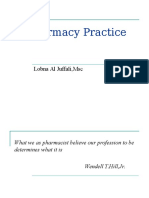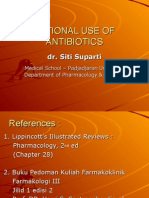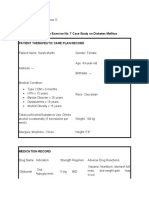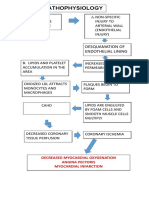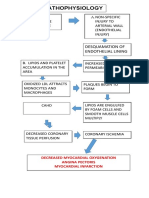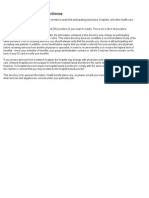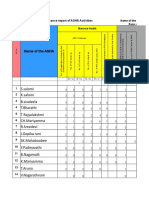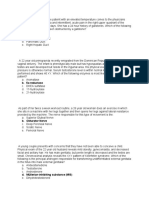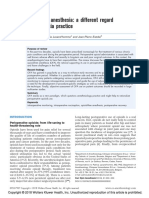Professional Documents
Culture Documents
Anthelmintics
Uploaded by
shaitabligan0 ratings0% found this document useful (0 votes)
213 views8 pagesAnthelmintics are drugs that expel parasitic worms and internal parasites from the body by stunning or killing them without harming the host. They work by inhibiting metabolic processes vital to the parasite but not the host, or ensuring the parasite is exposed to higher drug concentrations than host cells. Common anthelmintic drugs include albendazole, ivermectin, praziquantel, and pyrantel. When using anthelmintics, it is important to assess for contraindications, monitor liver function, perform stool tests to identify the parasite, and educate the patient.
Original Description:
Original Title
anthelmintics
Copyright
© © All Rights Reserved
Available Formats
PPTX, PDF, TXT or read online from Scribd
Share this document
Did you find this document useful?
Is this content inappropriate?
Report this DocumentAnthelmintics are drugs that expel parasitic worms and internal parasites from the body by stunning or killing them without harming the host. They work by inhibiting metabolic processes vital to the parasite but not the host, or ensuring the parasite is exposed to higher drug concentrations than host cells. Common anthelmintic drugs include albendazole, ivermectin, praziquantel, and pyrantel. When using anthelmintics, it is important to assess for contraindications, monitor liver function, perform stool tests to identify the parasite, and educate the patient.
Copyright:
© All Rights Reserved
Available Formats
Download as PPTX, PDF, TXT or read online from Scribd
0 ratings0% found this document useful (0 votes)
213 views8 pagesAnthelmintics
Uploaded by
shaitabliganAnthelmintics are drugs that expel parasitic worms and internal parasites from the body by stunning or killing them without harming the host. They work by inhibiting metabolic processes vital to the parasite but not the host, or ensuring the parasite is exposed to higher drug concentrations than host cells. Common anthelmintic drugs include albendazole, ivermectin, praziquantel, and pyrantel. When using anthelmintics, it is important to assess for contraindications, monitor liver function, perform stool tests to identify the parasite, and educate the patient.
Copyright:
© All Rights Reserved
Available Formats
Download as PPTX, PDF, TXT or read online from Scribd
You are on page 1of 8
ANTHELMINTIC DRUG
Anthelmintics or antihelminthics are group of
antiparasitic drugs that expel
parasitic worms and other internal
parasites from the body by either stunning or
killing them and without causing significant
damage to the host.
They may also be called vermifuges or vermicides
MECHANISM OF ACTION
Anthelmintics must be selectively toxic to the parasite.
This is usually achieved either by inhibiting metabolic
processes that are vital to the parasite but not vital to or
absent in the host, or by inherent pharmacokinetic
properties of the compound that cause the parasite to be
exposed to higher concentrations of the anthelmintic
than are the host cells.
While the precise mode of action of many
anthelmintics is not fully understood, the sites of action
and biochemical mechanisms of many of them are
generally known.
Mechanism of action
Based on the mechanism of action in parasites;
a) Drug affecting energy production
>inhibits of fumarate reductase and
glucose binding of tubulin in mitochondria
>inhibits of (mitocondria ) phosphorylation
>inhibits of glycolysis
Parasitic helminths must maintain an appropriate feeding
site, and nematodes and trematodes must actively ingest and
move food through their digestive tracts to maintain an
appropriate energy state; this and reproductive processes
require proper neuromuscular coordination.
Parasites must also maintain homeostasis despite host
immune reactions. The pharmacologic basis of the treatment
for helminths generally involves interference with the
integrity of parasite cells, neuromuscular coordination, or
protective mechanisms against host immunity, which lead to
starvation, paralysis, and expulsion or digestion of the
parasite.
Sample anthelminthics drug
Generic name Brand name
-Albendazole -Albenza
-Ivermectin -Stromectol
-Praziquantel -Biltricide
-Antiminth
-pyrantel -Pin-Ria
Special consideration
Assess for cautions and contraindication
example:
>known allergy
> hapatorenal dysfunction
> pregnancy and lactation
Perform thorough physical assessment
Assess liver function
Obtain culture of stool for ova and parasite to
determine the infecting worm and established
proper treatment
Assess the abdomen to evaluate for any changes
from baseline related to the infection
Arrange for appropriate culture and sensitivity
test
Educate client on drug therapy to promote
understanding
Provide comfort for safety measure if CNS effects
occur.
Monitor hepatic function and perform
ophthalmologist examination before and
periodically during treament.
THANK YOU!
You might also like
- Mechanisms of Drug Toxicity: Proceedings of the Third International Pharmacological MeetingFrom EverandMechanisms of Drug Toxicity: Proceedings of the Third International Pharmacological MeetingH. RaškováNo ratings yet
- Pharmacology M Pharm Syllabus KU 1Document15 pagesPharmacology M Pharm Syllabus KU 1Nagaraj YadavNo ratings yet
- Pharmacological Management of GIT Disorders For First Year Medicine StudentsDocument85 pagesPharmacological Management of GIT Disorders For First Year Medicine Studentsmex GbrekorkosNo ratings yet
- SamplesDocument4 pagesSamplesRalph Lawrence Ruiz Tagorda0% (1)
- Anthelmintics For Animal UseDocument20 pagesAnthelmintics For Animal UseSunil100% (2)
- PSG 252 Lecture 4 Peptic Ulcer and Gastro ProtectionDocument7 pagesPSG 252 Lecture 4 Peptic Ulcer and Gastro ProtectionMichael TobilobaNo ratings yet
- Generics Act of 1988Document5 pagesGenerics Act of 1988JIEZFANo ratings yet
- Guideline Antibiotic RationalDocument35 pagesGuideline Antibiotic RationalIstianah EsNo ratings yet
- Clinical Pharmacy Lab - Quiz Part 2Document4 pagesClinical Pharmacy Lab - Quiz Part 2Aassh DcmbrNo ratings yet
- Ward RoundDocument2 pagesWard RoundAnonymous whcvnPBeQNo ratings yet
- Classification of AntibioticsDocument14 pagesClassification of Antibioticsdoc_abdullahNo ratings yet
- Sangobion Full Report v1Document18 pagesSangobion Full Report v1aqibazizkhanNo ratings yet
- A Guide On Intravenous Drug Compatibilities Based On Their PHDocument10 pagesA Guide On Intravenous Drug Compatibilities Based On Their PHSergio M JuniorNo ratings yet
- Introduction To Pharmacoepidemiology 2015 PDFDocument20 pagesIntroduction To Pharmacoepidemiology 2015 PDFNovria Rizki HarahapNo ratings yet
- Mouse Handling Techniques PacketDocument24 pagesMouse Handling Techniques PacketLovely Ann AyapanaNo ratings yet
- Case Study SaladDocument7 pagesCase Study SaladrimNo ratings yet
- Statement of Principle Self-Care Including Self-Medication - The Professional Role of The PharmacistDocument5 pagesStatement of Principle Self-Care Including Self-Medication - The Professional Role of The PharmacistAprilia R. Permatasari0% (1)
- Adverse Drug ReactionDocument24 pagesAdverse Drug ReactionGopal pokhrelNo ratings yet
- 3B - Clinical PharmacyDocument35 pages3B - Clinical PharmacyekramNo ratings yet
- Pharmacology of The GITDocument31 pagesPharmacology of The GITmarviecute22No ratings yet
- Sample Case ScenarioDocument10 pagesSample Case ScenarioKarilee Salcedo AyunayunNo ratings yet
- Anti Protozoal AgentsDocument19 pagesAnti Protozoal AgentsNithish SNo ratings yet
- Anti InflammatoryDocument41 pagesAnti InflammatoryKakai Ablanque LopozNo ratings yet
- Mishba +pharmacology + Tapan ShahDocument232 pagesMishba +pharmacology + Tapan ShahRaushan BlakeNo ratings yet
- Bronchodilator & Other Drugs Used in AsthmaDocument15 pagesBronchodilator & Other Drugs Used in AsthmaGenta JagadNo ratings yet
- Factors Affecting Drug Metabolism PDFDocument2 pagesFactors Affecting Drug Metabolism PDFPaige50% (2)
- Pharmaceutical Care Plan and Documentaion of Pharmacotherapy Intervention (MTM)Document67 pagesPharmaceutical Care Plan and Documentaion of Pharmacotherapy Intervention (MTM)CAROL ANN PATITICONo ratings yet
- Medication HistoryDocument19 pagesMedication HistoryAnisha PandeyNo ratings yet
- Pharmacy Training - Gastro Intestinal TractDocument56 pagesPharmacy Training - Gastro Intestinal TractDylanSalam100% (1)
- Ward Round Participation & Drug Therapy MonitoringDocument20 pagesWard Round Participation & Drug Therapy MonitoringAman UpadhyayNo ratings yet
- Medical Law EthicsDocument30 pagesMedical Law EthicsImad AnwarNo ratings yet
- Antiviral Drugs Acting Against RNA Viruses: HIV: PHRM 412Document57 pagesAntiviral Drugs Acting Against RNA Viruses: HIV: PHRM 412Apurba Sarker ApuNo ratings yet
- Drug Distribution SystemDocument1 pageDrug Distribution SystemSufia SuptyNo ratings yet
- Patient Pharmacist InteractionDocument25 pagesPatient Pharmacist InteractionaneecaNo ratings yet
- Predisposing Factors of ADRsDocument7 pagesPredisposing Factors of ADRssuhas reddyNo ratings yet
- Primaxin IVDocument26 pagesPrimaxin IVkingdom5000No ratings yet
- Intro Drug DiscoveryDocument32 pagesIntro Drug Discoveryapi-19965961No ratings yet
- Pharm Chapter 2 and 3 Study GuideDocument10 pagesPharm Chapter 2 and 3 Study GuideamkNo ratings yet
- 023-Rational Use of DrugsDocument43 pages023-Rational Use of DrugsfikebatuNo ratings yet
- Adverse Drug Reactions NotesDocument4 pagesAdverse Drug Reactions NoteskarthikeyanpgtNo ratings yet
- AutacoidsDocument43 pagesAutacoidsOdiete EfeNo ratings yet
- Apollojames Lecturer Nandha College of PharmacyDocument19 pagesApollojames Lecturer Nandha College of PharmacySuresh ThanneruNo ratings yet
- TDM of LidocaineDocument19 pagesTDM of LidocaineNikkiiNo ratings yet
- Pharmacology Case StudyDocument4 pagesPharmacology Case StudyRichard S. RoxasNo ratings yet
- Rational Use of Drugs-IDocument38 pagesRational Use of Drugs-IUmair Mazhar100% (1)
- The Role of Clinical Pharmacist in Pharmacovigilance and Drug Safety in Teritiary Care Teaching HospitalDocument11 pagesThe Role of Clinical Pharmacist in Pharmacovigilance and Drug Safety in Teritiary Care Teaching HospitalBaru Chandrasekhar RaoNo ratings yet
- Anti Neoplastic and Immunosupressant DrugsDocument29 pagesAnti Neoplastic and Immunosupressant DrugsAshraf Moby100% (1)
- Pharmacists Role Clinical Pharmacokinetic MonitoringDocument2 pagesPharmacists Role Clinical Pharmacokinetic MonitoringauliaNo ratings yet
- Case Study - Parkinson'S Disease: Clinical Pharmacy & Therapeutics 1Document13 pagesCase Study - Parkinson'S Disease: Clinical Pharmacy & Therapeutics 1Jenesis Cairo CuaresmaNo ratings yet
- Common Drugs Use in OphthalmologyDocument40 pagesCommon Drugs Use in Ophthalmologyณัช เกษมNo ratings yet
- APPLICATION PROJECT 3: Drug Procurement & Inventory Control Kaye Erin B. Nadonga PH 4-ADocument5 pagesAPPLICATION PROJECT 3: Drug Procurement & Inventory Control Kaye Erin B. Nadonga PH 4-APrincess TiongsonNo ratings yet
- Pharmacy PracticeDocument17 pagesPharmacy PracticeP D SpencerNo ratings yet
- Patient Medication History Interview: Dr. Vijay B. Lambole Associate Professor, SNLPCP, UmrakhDocument20 pagesPatient Medication History Interview: Dr. Vijay B. Lambole Associate Professor, SNLPCP, Umrakhvijaylambole0% (1)
- WHO Safe PrescribingDocument16 pagesWHO Safe PrescribingAliyah NatasyaNo ratings yet
- Drugs Interaction1Document13 pagesDrugs Interaction1Akshay MandhotraNo ratings yet
- Rational Use of AntibioticsDocument32 pagesRational Use of AntibioticsRendy SusantoNo ratings yet
- Worksheet On Exercise No. 7 Case Study On Diabetes MellitusDocument9 pagesWorksheet On Exercise No. 7 Case Study On Diabetes Mellitusjameela sapiandanteNo ratings yet
- Antiviral DrugsDocument56 pagesAntiviral DrugsciccianoNo ratings yet
- Pharmacotherapeutics UNIT1Document44 pagesPharmacotherapeutics UNIT1Bharti ChauhanNo ratings yet
- Labelling and PackagingDocument16 pagesLabelling and PackagingvyshnosudhaNo ratings yet
- Trends Affecting NSG PracticeDocument22 pagesTrends Affecting NSG PracticeshaitabliganNo ratings yet
- Antiemetic DrugsDocument21 pagesAntiemetic DrugsshaitabliganNo ratings yet
- PenicillinDocument5 pagesPenicillinshaitabliganNo ratings yet
- Anti DiarrhealDocument5 pagesAnti DiarrhealshaitabliganNo ratings yet
- ANTACIDSDocument7 pagesANTACIDSshaitabliganNo ratings yet
- Developmental TheoriesDocument6 pagesDevelopmental TheoriesshaitabliganNo ratings yet
- Proclamation No. 499Document21 pagesProclamation No. 499shaitabliganNo ratings yet
- Anti-Spasmodic DrugsDocument8 pagesAnti-Spasmodic DrugsshaitabliganNo ratings yet
- ChloramphenicolDocument9 pagesChloramphenicolshaitabliganNo ratings yet
- Cephalosporins Batch 1Document11 pagesCephalosporins Batch 1shaitabliganNo ratings yet
- MACROLIDESDocument8 pagesMACROLIDESshaitabliganNo ratings yet
- AminoglycosidesDocument17 pagesAminoglycosidesshaitabliganNo ratings yet
- Cephalosphorins 3rd Gen 4rt GenDocument24 pagesCephalosphorins 3rd Gen 4rt GenshaitabliganNo ratings yet
- Mechanisms of Action OF Antifungal AgentsDocument5 pagesMechanisms of Action OF Antifungal AgentsshaitabliganNo ratings yet
- Anti-Malarial DrugDocument6 pagesAnti-Malarial DrugshaitabliganNo ratings yet
- Anti-Leprotic DrugsDocument9 pagesAnti-Leprotic DrugsshaitabliganNo ratings yet
- Gastric Cancer and PancreaticDocument48 pagesGastric Cancer and PancreaticshaitabliganNo ratings yet
- DM 1Document43 pagesDM 1shaitabliganNo ratings yet
- Burgers DiseaseDocument21 pagesBurgers DiseaseshaitabliganNo ratings yet
- Pathophys of CADDocument1 pagePathophys of CADshaitabliganNo ratings yet
- Antibacterial CombinationsDocument21 pagesAntibacterial CombinationsshaitabliganNo ratings yet
- Pathophysiology: Risk FactorsDocument1 pagePathophysiology: Risk FactorsshaitabliganNo ratings yet
- Coronary Artery DiseaseDocument38 pagesCoronary Artery Diseaseshaitabligan100% (2)
- BronchitisDocument18 pagesBronchitisshaitabliganNo ratings yet
- AnginaDocument4 pagesAnginashaitabliganNo ratings yet
- Bronchial AsthmaDocument21 pagesBronchial AsthmashaitabliganNo ratings yet
- Cerebrovascular Accident: EpidemiologyDocument6 pagesCerebrovascular Accident: EpidemiologyshaitabliganNo ratings yet
- Chronic Obstructive Pulmunary DiseaseDocument39 pagesChronic Obstructive Pulmunary DiseaseshaitabliganNo ratings yet
- Epidemiology: Arrhythmia/DysrhythmiaDocument6 pagesEpidemiology: Arrhythmia/DysrhythmiashaitabliganNo ratings yet
- Coronary Artery Stent Thrombosis - Incidence and Risk Factors - UpToDateDocument21 pagesCoronary Artery Stent Thrombosis - Incidence and Risk Factors - UpToDateCarlos Rubio LópezNo ratings yet
- GEMP 3 2020 Advice & TestsDocument52 pagesGEMP 3 2020 Advice & TestsTresor KabambaNo ratings yet
- Autism PaperDocument5 pagesAutism PaperMaggie NielsenNo ratings yet
- Trusted Medical Answers-In Seconds.: Helminth InfectionsDocument33 pagesTrusted Medical Answers-In Seconds.: Helminth InfectionsntnquynhproNo ratings yet
- Leech TherapyDocument2 pagesLeech TherapyEmelda MelNo ratings yet
- Important Information About Your Online DirectoryDocument17 pagesImportant Information About Your Online Directoryc__bNo ratings yet
- BleedingDocument72 pagesBleedingRHENCE TEJERONo ratings yet
- MODULARIS Variostar 510 (K) Siemens Medical Solutions USA, IncDocument8 pagesMODULARIS Variostar 510 (K) Siemens Medical Solutions USA, IncGuilherme NevesNo ratings yet
- Ward DrugsDocument5 pagesWard DrugsMary Grace AgataNo ratings yet
- Pain Management in AnimalsDocument184 pagesPain Management in Animalsssarbovan100% (1)
- The Endocrine System and Glands of The Human BodyDocument2 pagesThe Endocrine System and Glands of The Human BodyFungo JasmineNo ratings yet
- Veterinary PathologyDocument9 pagesVeterinary PathologyamjadNo ratings yet
- Localized Dental Abrasion Caused by An Unusually Vicious Habit: Cases Report and Literature ReviewDocument8 pagesLocalized Dental Abrasion Caused by An Unusually Vicious Habit: Cases Report and Literature ReviewTheodora ComanNo ratings yet
- Overview of and Approach To The Vasculitides in AdultsDocument25 pagesOverview of and Approach To The Vasculitides in AdultsHello AngelNo ratings yet
- Vocabulary Work Book Check Your English Vocabulary For MedicineDocument50 pagesVocabulary Work Book Check Your English Vocabulary For MedicineMarius Belean100% (1)
- Diabetes Urdu OnDocument35 pagesDiabetes Urdu OnShahid AminNo ratings yet
- Reproductive SystemDocument56 pagesReproductive SystemRochelle Ann CunananNo ratings yet
- Cardiopulmonary Physiotherapy in Trauma An Evidence-Based ApproachDocument3 pagesCardiopulmonary Physiotherapy in Trauma An Evidence-Based ApproachGme RpNo ratings yet
- Asha Monthly Reports - Aprial MonthDocument64 pagesAsha Monthly Reports - Aprial MonthSamuel SourabNo ratings yet
- PijhjiiiiDocument14 pagesPijhjiiiiSofiNo ratings yet
- Alloderm - Breast ReconstructionDocument180 pagesAlloderm - Breast ReconstructionFlorina PopaNo ratings yet
- Dialog Patient AdmissionDocument3 pagesDialog Patient AdmissionYunita TriscaNo ratings yet
- The Effects of Topical Burow's and Castellani's Solutions On The Middle Ear Mucosa of RatsDocument4 pagesThe Effects of Topical Burow's and Castellani's Solutions On The Middle Ear Mucosa of RatsPerm PermNo ratings yet
- Eco ModelDocument3 pagesEco ModelMary Joyce Juat DayotNo ratings yet
- Obana ProtocolDocument4 pagesObana Protocolpaiskopaxiew888No ratings yet
- Questions AnatDocument13 pagesQuestions AnatAfaq RazaNo ratings yet
- 120 HAAD Exam QuestionsDocument10 pages120 HAAD Exam QuestionsConsolacion Binarao Dolores50% (8)
- Interdisciplinary Interface Between Fixed Prosthodontics and PeriodonticsDocument23 pagesInterdisciplinary Interface Between Fixed Prosthodontics and Periodonticsaziz20070% (1)
- 1st Periodic Test - Science 9Document3 pages1st Periodic Test - Science 9Irish Jhaizel Kaye FuentesNo ratings yet
- Opioid Free Anesthesia A Different Regard To.98965 PDFDocument6 pagesOpioid Free Anesthesia A Different Regard To.98965 PDFgabriel herreraNo ratings yet















